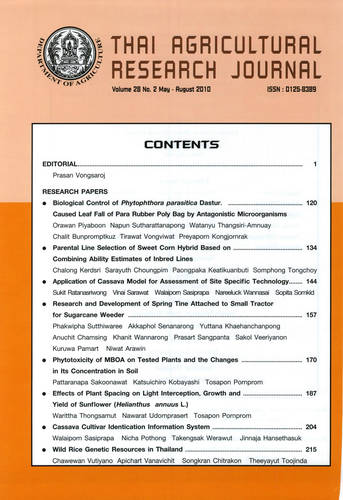Biological Control of Phytophthora parasitica Dastur. Caused Leaf Fall of Para Rubber Poly Bag by Antagonistic Microorganisms.
DOI:
https://doi.org/10.14456/thaidoa-agres.2010.3Keywords:
para rubber poly bag, Hevea brasiliensis, leaf fall, Phytophthora parasitica, antagonistic microorganismAbstract
Para rubber is an important economic plant of Thailand. However, para rubber farmers confront a problem of leaf fall due to Phytophthora. The efficiencies of antagonistic microorganisms namely Trichoderma harzianum CB-Pin-01, T. harzianum PM 51, Bacillus subtilis, and B. amyloliquefaciens were studies to control Phytophthora parasitica at the Department of Biology. Mahidol Witayanusorn school, Nakhon Pathom province during June 2007- May 2009. T. harzianum CB –PIN-01 and T. harzianum PM 51, B. subtilis, and B. amyloliquefaciens were put on trial to inhibit the growth of P. parasitica by dual culture tests. Antagonistic microorganisms had inhibited the growth of P. parasitica and the two isolates, T. harzianum CB-Pin-01 and T. harzianum PM 51 had more efficiency than B. spp. In field setting, para rubber poly bag were growth in the soil by mixed with P. parasitica and then antagonistic microorganisms were sprayed on these para rubber poly bag every 3 day. The result was found by calculating percentage of disease control that the efficiencies of the two strains of T. harzianum were not singnificantly different and T. harzinum PM 51 had significantly more efficent than B. spp., but were equally efficient with metalaxyl.
Downloads
Published
How to Cite
Issue
Section
License
Copyright (c) 2017 วารสารวิชาการเกษตร (Thai Agricultural Research Journal)

This work is licensed under a Creative Commons Attribution-NonCommercial-NoDerivatives 4.0 International License.
Thai Agricultural Research Journal



